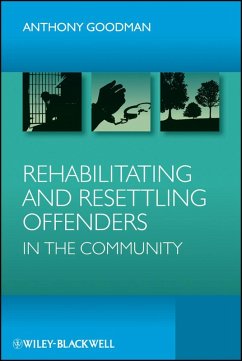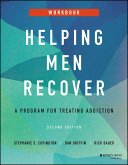Rehabilitating and Resettling Offenders in the Community (eBook, PDF)


Alle Infos zum eBook verschenken

Rehabilitating and Resettling Offenders in the Community (eBook, PDF)
- Format: PDF
- Merkliste
- Auf die Merkliste
- Bewerten Bewerten
- Teilen
- Produkt teilen
- Produkterinnerung
- Produkterinnerung

Hier können Sie sich einloggen

Bitte loggen Sie sich zunächst in Ihr Kundenkonto ein oder registrieren Sie sich bei bücher.de, um das eBook-Abo tolino select nutzen zu können.
Rehabilitating and Resettling Offenders in the Community is a significant examination of the historical development of work with offenders and their treatment by the state and society. It offers unique perspectives and a wealth of information drawn from numerous interviews with probation staff. * Highlights how the work of probation staff has changed over time and the reasons behind these changes * Includes discourse with probation staff carried out over many years for a comprehensive, 'insiders' view of the situation * Focuses on contemporary issues, including the changes brought in by the…mehr
- Geräte: PC
- mit Kopierschutz
- eBook Hilfe
- Größe: 1.95MB
![The Wiley Handbook on What Works for Offenders with Intellectual and Developmental Disabilities (eBook, PDF) The Wiley Handbook on What Works for Offenders with Intellectual and Developmental Disabilities (eBook, PDF)]() The Wiley Handbook on What Works for Offenders with Intellectual and Developmental Disabilities (eBook, PDF)43,99 €
The Wiley Handbook on What Works for Offenders with Intellectual and Developmental Disabilities (eBook, PDF)43,99 €![The Wiley Handbook of What Works with Sexual Offenders (eBook, PDF) The Wiley Handbook of What Works with Sexual Offenders (eBook, PDF)]() The Wiley Handbook of What Works with Sexual Offenders (eBook, PDF)159,99 €
The Wiley Handbook of What Works with Sexual Offenders (eBook, PDF)159,99 €![Offender Rehabilitation and Treatment (eBook, PDF) Offender Rehabilitation and Treatment (eBook, PDF)]() Offender Rehabilitation and Treatment (eBook, PDF)193,95 €
Offender Rehabilitation and Treatment (eBook, PDF)193,95 €![Treatment of High-Risk Sexual Offenders (eBook, PDF) Treatment of High-Risk Sexual Offenders (eBook, PDF)]() Jeffrey AbracenTreatment of High-Risk Sexual Offenders (eBook, PDF)40,99 €
Jeffrey AbracenTreatment of High-Risk Sexual Offenders (eBook, PDF)40,99 €![Helping Men Recover (eBook, PDF) Helping Men Recover (eBook, PDF)]() Stephanie S. CovingtonHelping Men Recover (eBook, PDF)131,99 €
Stephanie S. CovingtonHelping Men Recover (eBook, PDF)131,99 €![Helping Men Recover (eBook, PDF) Helping Men Recover (eBook, PDF)]() Stephanie S. CovingtonHelping Men Recover (eBook, PDF)26,99 €
Stephanie S. CovingtonHelping Men Recover (eBook, PDF)26,99 €![The Wiley-Blackwell Handbook of Mood Disorders (eBook, PDF) The Wiley-Blackwell Handbook of Mood Disorders (eBook, PDF)]() The Wiley-Blackwell Handbook of Mood Disorders (eBook, PDF)150,99 €
The Wiley-Blackwell Handbook of Mood Disorders (eBook, PDF)150,99 €-
-
-
Dieser Download kann aus rechtlichen Gründen nur mit Rechnungsadresse in A, B, BG, CY, CZ, D, DK, EW, E, FIN, F, GR, HR, H, IRL, I, LT, L, LR, M, NL, PL, P, R, S, SLO, SK ausgeliefert werden.
- Produktdetails
- Verlag: John Wiley & Sons
- Seitenzahl: 248
- Erscheinungstermin: 25. Mai 2012
- Englisch
- ISBN-13: 9781118312223
- Artikelnr.: 38256120
- Verlag: John Wiley & Sons
- Seitenzahl: 248
- Erscheinungstermin: 25. Mai 2012
- Englisch
- ISBN-13: 9781118312223
- Artikelnr.: 38256120
- Herstellerkennzeichnung Die Herstellerinformationen sind derzeit nicht verfügbar.
Acknowledgements xii
1 Introduction: How Should We Treat Offenders and What Can We Learn from
the Past? 1
Personal Experience 3
From Professional to Technical Skills 7
Fast-Track Punishment 8
What Works? 9
The Future of Professional Practice 10
Structure and Contents 11
2 The Early History of Punishing Offenders: Punishments and Help Offered to
Those Incarcerated 15
The Role of Religion and Offenders 16
Techniques for Gaining Control of the Population 17
The Threat of the Destitute 19
The Growth of the Prison System 20
The Export of Offenders 20
Positive Custody? 22
Circumventing the Gallows 22
Ensuring Punishment 25
Dealing with the Children: Reformatories 27
Dealing with Adults: Prison and Punishment 28
Summary 31
3 The Probation Service from its Inception until 1984: From Rescuing the
Fallen to a Centrally Managed Organization 33
From a Primitive to an Industrial Society 33
Making Offenders Productive 34
Issues of Power: From Control of the Body to Control of the Mind 35
The Early History of the Probation Service 37
From the Mission to Social Work with Offenders 41
The Middle Period of Probation 43
The Incompatibility of Breaching Orders with Traditional Notions of
Casework 44
From the Pessimism of 'Nothing Works' to 'What Works?' 46
The Professional Identity of Probation Officers 47
The Home Office and Probation: Turning the Screw 49
'Just Deserts' and the Increase in Compulsory Supervision 51
Summary 53
4 The Probation Service after 1984: From Social Work to Social Control and
Punishment 54
The Probation Task and 'Taylorism' 54
Punishment in the Community 55
Control Over Probation: The Role of Her Majesty's Inspectorate of Probation
and Themed Inspections 58
A New Report: Probation Services Working in Partnership: Increasing Value
for Money 59
The Work of Prison Probation Departments Report 59
Exercising Constant Vigilance: The Role of the Probation Service in
Protecting the Public from Sex Offenders, Report (1998) 60
Towards Race Equality (2000) 61
The Growth of Managerialism 62
From Casework to Corrections 63
Changes to the Influence of Probation in the Court Setting 65
Probation and New Labour 68
Just Deserts 70
Probation and the Punitive Tendency 71
Social Exclusion 72
Summary 83
5 Deconstructing National Standards for the Supervision of Offenders in the
Community 84
Background to the Analysis 85
Context 87
The typographical layout of NS 1992 and NS 1995 88
The discursive levels of NS 1992 and NS 1995 88
Textual Cohesion in NS 1992 and NS 1995 93
Surface grammatical structure of NS 1992 and NS 1995 94
The narrative level of NS 1992 and NS 1995 96
The semiotic square of NS 1992 and NS 1995 97
Commentary 99
National Standards 2000 100
National Standards 2002 (A Revised Version of NS 2000) 101
Discursive level 101
Lexical fields in NS 2002 (Home Office, 2002) 102
The semiotic square of NS 2002 102
National Standards 2005 103
National Standards 2007 103
Lexical fields in NS 2007 105
The semiotic square of NS 2007 106
Discrimination and the semiotic square 107
Summary 108
6 Views of Front-Line Staff 111
Setting the Context: The Opinion of Probation Service Professionals 111
What Happens During a Period of Change? The Early 1990s 111
On the Cusp of Change: Life Before and After National Standards 1995 114
Changes in the bureaucratic tasks of the Probation Service 114
Processing offenders 115
Taking offenders back to court (breaching) 117
Coping with the changes 118
Recording contact with offenders 119
Contact with prisoners 122
Understanding the World of the Offender 123
Discrimination and Offenders 125
Discrimination and Staff 126
'Advise, Assist and Befriend' 127
Changes in the Skills Base of Probation Officers 128
Probation Officers: Case Managers, not Case Workers? 130
Engaging with a Different Type of Offender 132
The Organizational Response 134
Morale and Issues of Control 137
Where did this Leave the Probation Service? 138
Bureaucratic tasks 138
Control, therapeutic work and the value base 138
Changes in probation practice, and its skills base 140
Responses to the Changing Offender Profile and 'Effective Practice'
Initiatives 140
Why Staff Believed the Changes were Taking Place 141
Transitions and Change in Probation Practice 142
7 After-Care and Resettlement in the Inner London Probation Service
(1965-1990) 147
The Professionalization of the ACU 151
Records 151
Finances 151
Clothing - WRVS 152
Community Service Volunteers (CSVs) 152
The Beginning: the Operation of the ACU 152
Analysis of casual callers in 1966 153
The Early Years of the ACU 153
A Hostel Run by a Probation Officer 155
The Maintenance of the Voluntary Tradition in Probation 158
An Evaluation of the ACU by the Home Office Research Unit 161
The ACU from the 1970s Until its Closure 165
The ACU at the Time of the Home Office's SNOP Document 166
Work with casual callers 167
1986: the ACU After the Division into Specialisms 169
Changes to the work with casual callers 170
The Pressure on Staff to Move from Resettlement to Mainstream Work 171
The Senior Management View of the ACU 173
1987: The Year of Consolidation 175
Summary 177
8 Through-Care and After-Care of Offenders by the National Offender
Management Service 179
Background 179
The Probation Service Takes Over Prison Welfare and Working with Prisoners
179
The Professionalization of Welfare Work with Prisoners and Ex-prisoners 182
Changes Since Probation Became Part of NOMS 186
National Standards (NS): PPU and OM Teams 188
Summary 193
9 Issues Around Rehabilitation 195
Using History as an Indicator of Future Social Problems 195
What does it Mean to be a Professional? 196
Life in the Community 197
Operating in the Criminal Justice System 199
Toughening up the System and Alternative Approaches 202
Supervision, NOMS and (in)Flexibility? 204
Risk and its Assessment 205
The Government, Probation and the Future 206
References 208
Further Reading 222
Index 227
Acknowledgements xii
1 Introduction: How Should We Treat Offenders and What Can We Learn from
the Past? 1
Personal Experience 3
From Professional to Technical Skills 7
Fast-Track Punishment 8
What Works? 9
The Future of Professional Practice 10
Structure and Contents 11
2 The Early History of Punishing Offenders: Punishments and Help Offered to
Those Incarcerated 15
The Role of Religion and Offenders 16
Techniques for Gaining Control of the Population 17
The Threat of the Destitute 19
The Growth of the Prison System 20
The Export of Offenders 20
Positive Custody? 22
Circumventing the Gallows 22
Ensuring Punishment 25
Dealing with the Children: Reformatories 27
Dealing with Adults: Prison and Punishment 28
Summary 31
3 The Probation Service from its Inception until 1984: From Rescuing the
Fallen to a Centrally Managed Organization 33
From a Primitive to an Industrial Society 33
Making Offenders Productive 34
Issues of Power: From Control of the Body to Control of the Mind 35
The Early History of the Probation Service 37
From the Mission to Social Work with Offenders 41
The Middle Period of Probation 43
The Incompatibility of Breaching Orders with Traditional Notions of
Casework 44
From the Pessimism of 'Nothing Works' to 'What Works?' 46
The Professional Identity of Probation Officers 47
The Home Office and Probation: Turning the Screw 49
'Just Deserts' and the Increase in Compulsory Supervision 51
Summary 53
4 The Probation Service after 1984: From Social Work to Social Control and
Punishment 54
The Probation Task and 'Taylorism' 54
Punishment in the Community 55
Control Over Probation: The Role of Her Majesty's Inspectorate of Probation
and Themed Inspections 58
A New Report: Probation Services Working in Partnership: Increasing Value
for Money 59
The Work of Prison Probation Departments Report 59
Exercising Constant Vigilance: The Role of the Probation Service in
Protecting the Public from Sex Offenders, Report (1998) 60
Towards Race Equality (2000) 61
The Growth of Managerialism 62
From Casework to Corrections 63
Changes to the Influence of Probation in the Court Setting 65
Probation and New Labour 68
Just Deserts 70
Probation and the Punitive Tendency 71
Social Exclusion 72
Summary 83
5 Deconstructing National Standards for the Supervision of Offenders in the
Community 84
Background to the Analysis 85
Context 87
The typographical layout of NS 1992 and NS 1995 88
The discursive levels of NS 1992 and NS 1995 88
Textual Cohesion in NS 1992 and NS 1995 93
Surface grammatical structure of NS 1992 and NS 1995 94
The narrative level of NS 1992 and NS 1995 96
The semiotic square of NS 1992 and NS 1995 97
Commentary 99
National Standards 2000 100
National Standards 2002 (A Revised Version of NS 2000) 101
Discursive level 101
Lexical fields in NS 2002 (Home Office, 2002) 102
The semiotic square of NS 2002 102
National Standards 2005 103
National Standards 2007 103
Lexical fields in NS 2007 105
The semiotic square of NS 2007 106
Discrimination and the semiotic square 107
Summary 108
6 Views of Front-Line Staff 111
Setting the Context: The Opinion of Probation Service Professionals 111
What Happens During a Period of Change? The Early 1990s 111
On the Cusp of Change: Life Before and After National Standards 1995 114
Changes in the bureaucratic tasks of the Probation Service 114
Processing offenders 115
Taking offenders back to court (breaching) 117
Coping with the changes 118
Recording contact with offenders 119
Contact with prisoners 122
Understanding the World of the Offender 123
Discrimination and Offenders 125
Discrimination and Staff 126
'Advise, Assist and Befriend' 127
Changes in the Skills Base of Probation Officers 128
Probation Officers: Case Managers, not Case Workers? 130
Engaging with a Different Type of Offender 132
The Organizational Response 134
Morale and Issues of Control 137
Where did this Leave the Probation Service? 138
Bureaucratic tasks 138
Control, therapeutic work and the value base 138
Changes in probation practice, and its skills base 140
Responses to the Changing Offender Profile and 'Effective Practice'
Initiatives 140
Why Staff Believed the Changes were Taking Place 141
Transitions and Change in Probation Practice 142
7 After-Care and Resettlement in the Inner London Probation Service
(1965-1990) 147
The Professionalization of the ACU 151
Records 151
Finances 151
Clothing - WRVS 152
Community Service Volunteers (CSVs) 152
The Beginning: the Operation of the ACU 152
Analysis of casual callers in 1966 153
The Early Years of the ACU 153
A Hostel Run by a Probation Officer 155
The Maintenance of the Voluntary Tradition in Probation 158
An Evaluation of the ACU by the Home Office Research Unit 161
The ACU from the 1970s Until its Closure 165
The ACU at the Time of the Home Office's SNOP Document 166
Work with casual callers 167
1986: the ACU After the Division into Specialisms 169
Changes to the work with casual callers 170
The Pressure on Staff to Move from Resettlement to Mainstream Work 171
The Senior Management View of the ACU 173
1987: The Year of Consolidation 175
Summary 177
8 Through-Care and After-Care of Offenders by the National Offender
Management Service 179
Background 179
The Probation Service Takes Over Prison Welfare and Working with Prisoners
179
The Professionalization of Welfare Work with Prisoners and Ex-prisoners 182
Changes Since Probation Became Part of NOMS 186
National Standards (NS): PPU and OM Teams 188
Summary 193
9 Issues Around Rehabilitation 195
Using History as an Indicator of Future Social Problems 195
What does it Mean to be a Professional? 196
Life in the Community 197
Operating in the Criminal Justice System 199
Toughening up the System and Alternative Approaches 202
Supervision, NOMS and (in)Flexibility? 204
Risk and its Assessment 205
The Government, Probation and the Future 206
References 208
Further Reading 222
Index 227







